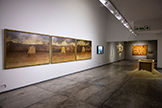Canto abierto: Homenaje a Jorge Eduardo Eielson
En Lima, la Pontificia Universidad Católica (PUCP) organizó del 7 al 13 de abril el festival Eielson 100, donde se reflexionó sobre la significancia de la obra temprana de Jorge Eduardo Eielson, su vida en la capital peruana y las repercusiones del exilio en Francia e Italia después de la Segunda Guerra Mundial. El evento también exploró su interacción con la cultura europea y su constante reflexión geopolítica sobre el Perú y Latinoamérica a través de su trabajo artístico.
La semana de celebración comenzó con un simposio que reunió a tres destacados especialistas en la obra de Jorge Eduardo Eielson: los profesores Martha Canfield (en calidad de directora del Centro Studi Jorge Eielson en Florencia), William Rowe (Birkbeck, Universidad de Londres) y Luis Rebaza Soraluz (King’s College, Londres).
En el marco del festival, se organizaron las muestras Canto abierto: Homenaje a Jorge Eduardo Eielson y Habitación en Roma, ambas curadas por Mariana Rodríguez Barreno y Carlos Castro Sajami.
Canto abierto reunió a 11 artistas peruanos de distintas generaciones cuyas obras dialogan con el legado artístico de Jorge Eduardo Eielson. La muestra, que estuvo abierta al público del 11 de abril al 12 de mayo, se estructuró en cuatro ejes representativos de su producción artística: la apropiación del arte del antiguo Perú, el paisaje del litoral peruano, el entramado de materiales y el espacio estelar.
A partir de estos núcleos, los artistas Nereida Apaza, Luz María Bedoya, María José Guerrero, Billy Hare, Rafael Hastings, Alejandra Ortiz de Zevallos, Carlos Runcie Tanaka, Paola Torres, Esther Vainstein, Silvia Westphalen y Ricardo Wiesse conectaron sus obras de manera original con los temas presentes en la obra de Eielson, utilizando medios como la fotografía, la pintura, el videoarte, la escultura y la instalación.” (Artishock 13.06.2024)
“(...)Eielson 100
In Lima, the Pontifical Catholic University of Peru (PUCP) organized the Eielson 100 festival from April 7 to 13, reflecting on the significance of the early work of Jorge Eduardo Eielson, his life in the Peruvian capital, and the repercussions of his exile in France and Italy after the Second World War. The event also explored his interaction with European culture and his ongoing geopolitical reflections on Peru and Latin America through his artistic practice.
The week of celebrations began with a symposium that brought together three leading specialists in Eielson’s work: professors Martha Canfield (director of the Centro Studi Jorge Eielson in Florence), William Rowe (Birkbeck, University of London), and Luis Rebaza Soraluz (King’s College, London).
As part of the festival, two exhibitions were organized: Canto abierto: Homenaje a Jorge Eduardo Eielson and Habitación en Roma, both curated by Mariana Rodríguez Barreno and Carlos Castro Sajami.
Canto abierto brought together eleven Peruvian artists from different generations whose works engaged with Eielson’s artistic legacy. The exhibition, open to the public from April 11 to May 12, was structured around four central axes of his artistic production: the appropriation of ancient Peruvian art, the Peruvian coastal landscape, the interweaving of materials, and the stellar realm.
Drawing from these themes, artists Nereida Apaza, Luz María Bedoya, María José Guerrero, Billy Hare, Rafael Hastings, Alejandra Ortiz de Zevallos, Carlos Runcie Tanaka, Paola Torres, Esther Vainstein, Silvia Westphalen, and Ricardo Wiesse connected their works in original ways with the concerns present in Eielson’s practice, working across media such as photography, painting, video art, sculpture, and installation.(...)”
(Artishock, 13.06.2024)



